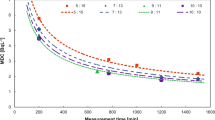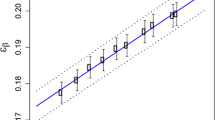Abstract
A sensitive method for determination of low-level tritium in seawater samples was established by enrichment of tritium from large volume of seawater using electrolysis and ultra-low level liquid scintillation counting measurement. A constant and optimal overall measurement efficiency of tritium was obtained by controlling the electrolysis conditions and optimizing the measurement parameters. A detection limit of this method of 0.45 TU for tritium was achieved using 700 mL seawater samples, which enables to determine tritium in most of seawater except for some deep seawater. The developed method has been applied for determination of tritium in the East China Sea.




Similar content being viewed by others
References
Lucas LL, Unterweger MP (2000) Comprehensive review and critical evaluation of the half-life of tritium. J Res Natl Inst Stand Technol 105:541–549
Grosse AV, Johnston WM, Wolfgang RL, Libby WF (1951) Tritium in nature. Science 113:1–2
Feng B, Chen B, Zhao C, He LF, Tang FD, Zhuo WH (2020) Application of a liquid scintillation system with 100-ml counting vials for environmental tritium determination: procedure optimization, performance test, and uncertainty analysis. J Environ Radioact 225:106427
Oms PE, du Bois PB, Dumas F, Lazure P, Morillon M, Voiseux C, Le Corre C, Cossonnet C, Solier L, Morin P (2019) Inventory and distribution of tritium in the oceans in 2016. Sci Total Environ 656:1289–1303
Povinec PP, Lee SH, Kwong LLW, Oregioni B, Jull AJT, Kieser WE, Morgenstern U, Top Z (2010) Tritium, radiocarbon, 90Sr and 129I in the Pacific and Indian Oceans. Nucl Instrum Meth B 268:1214–1218
Palcsu L, Major Z, Kollo Z, Papp L (2010) Using an ultrapure 4He spike in tritium measurements of environmental water samples by the 3He-ingrowth method. Rapid Commun Mass Spectr 24:698–704
Gomes AR, Abrantes J, Libanio A, Madruga MJ, Reis M (2017) Determination of tritium in water using electrolytic enrichment: methodology improvements. J Radioannal Nucl Chem 314:669–674
Lin F, Yu T, Yu W, Ni JL, Lin L (2020) Electrolytic enrichment method for tritium determination in the Arctic Ocean using liquid scintillation counter. Acta Oceanol Sin 39:73–77
Morgenstern U, Taylor CB (2009) Ultra low-level tritium measurement using electrolytic enrichment and LSC. Isotopes Environ Health Stud 45:96–117
Plastino W, Chereji I, Cuna S, Kaihola L, De Felice P, Lupsa N, Balas G, Mirel V, Berdea P, Baciu C (2007) Tritium in water electrolytic enrichment and liquid scintillation counting. Radiat Meas 42:68–73
Soreefan AM, DeVol TA (2009) Determination of tritium enrichment parameters of a commercially available PEM electrolyzer: a comparison with conventional enrichment electrolysis. J Radioannal Nucl Chem 282:511–515
Ma XZ, Song Y, Liu SB, Jiang L, Hong F (2013) Origin, age, and evolution of water in coal reservoirs: evidence from halogen ions, stable isotopes and 129I. Sci Sin Terr 43:1699–1707
Hou XL (2005) Rapid analysis of 14C and 3H in graphite and concrete for decommissioning of nuclear reactor. Appl Radiat Isot 62:871–882
Currie LA (1968) Limits for qualitative detection and quantitative determination. Application to radiochemistry. Anal Chem 40:586–593
Luo YJ, Hou XL, Qiao JX, Zhu LC, Zheng CB, Lin M (2022) Determination of 93Mo in radioactive samples of sulfuric acid media from nuclear facilities. Anal Chem 94:11582–11590
Groning M, Rozanski K (2003) Uncertainty assessment of environmental tritium measurements in water. Accredit Qual Assur 8:359–366
L’ Annunziata MF, (2012) Handbook of radioactivity analysis. Elsevier Science, Amsterdam
Palomo M, Penalver A, Aguilar C, Borrull F (2007) Tritium activity levels in environmental water samples from different origins. Appl Radiat Isot 65:1048–1056
Deng K, Wang L, Xia ZH, Ma YH, Qin LL, Zhang Q, Liu YJ, Yao J, Liu W (2018) Tritium concentrations in precipitation in Shanghai. Nucl Sci Tech 29:1–6
Varlam C, Patrascu V, Margineanu RM, Faurescu I, Vagner I, Faurescu D, Duliu OG (2013) Tritium activity concentration along the Western shore of the Black Sea. J Radioannal Nucl Chem 298:1679–1683
Acknowledgements
This work was financially supported by Chinese Academy of Sciences (ZDBS-SSW-DQC003; International Partnership Program No. 132B61KYSB20180003), Seawater samples were collected onboard of R/V “Kexue III” implementing the open research cruise 2021 supported by the Yangtze Estuary Ecosystem Research Station of IOCAS.
Author information
Authors and Affiliations
Corresponding author
Ethics declarations
Conflict of interest
The authors declare that they have no conflict of interest.
Additional information
Publisher's Note
Springer Nature remains neutral with regard to jurisdictional claims in published maps and institutional affiliations.
Rights and permissions
Springer Nature or its licensor (e.g. a society or other partner) holds exclusive rights to this article under a publishing agreement with the author(s) or other rightsholder(s); author self-archiving of the accepted manuscript version of this article is solely governed by the terms of such publishing agreement and applicable law.
About this article
Cite this article
Zhang, T., Jiang, H., Chen, N. et al. Determination of tritium in large volume of seawater using electrolytic enrichment and LSC and its application for the East China Sea water. J Radioanal Nucl Chem 332, 981–987 (2023). https://doi.org/10.1007/s10967-022-08752-w
Received:
Accepted:
Published:
Issue Date:
DOI: https://doi.org/10.1007/s10967-022-08752-w




